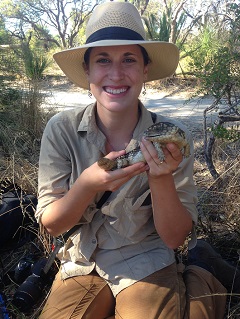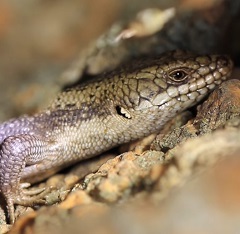Lizards and ladders
 Social rearing has little effect on a lizard’s ability to navigate through a complex maze of ladders, according to a team of researchers including Professor Richard Byrne in University of St Andrews’ School of Psychology and Neuroscience.
Social rearing has little effect on a lizard’s ability to navigate through a complex maze of ladders, according to a team of researchers including Professor Richard Byrne in University of St Andrews’ School of Psychology and Neuroscience.
The report, published today in Animal Cognition, represents an important breakthrough in our understanding the evolution of cognitive abilities and how they can be affected by rearing environment. Previous research had suggested animals with complex social structures would benefit from a social environment during development, and thereby acquire more powerful learning abilities. However, today’s findings force scientists to think again.
Julia Riley, PhD candidate at Macquarie University (pictured), explains: “Previous studies have shown that for social mammals and birds – including humans, rats, monkeys, and chickens – being removed from social contact during development negatively affects how they grow up. Individuals raised alone are more fearful, anxious, more sedentary, less social, and have a harder time learning. But so far, no one has looked at how being raised away from other individuals would affect a social reptile.”
Julia and colleague Martin Whiting teamed up with the University of St Andrews’ Professor Byrne, and Dr Dan Noble from the University of New South Wales, to conduct the world’s first examination of how early social environment affects lizard learning.
The team found that the learning ability of the Australian Tree Skink is not helped by growing up with others, but that these lizards were able to learn to navigate a complex spatial maze just as well whether they grew up living by themselves or with a “room-mate”.
Australian Tree Skinks (Egernia striolata – pictured below) are a common lizard found throughout south-eastern Australia. In the wild, these lizards often live in family groups. Usually parents and offspring are found together, but each lizard varies in how social it likes to be – there are loners, and also social butterflies that are always found with other lizards. This variable social nature makes the Australian Tree Skink an ideal species to study how a social environment during development might affect lizard behaviour.
They raised Tree Skinks alone or paired with another juvenile until they were about a year old. They then presented each lizard with a spatial maze. The lizard had to navigate a set of five ladders and three ledges to get a food reward. Only two of the five ladders were climbable, and the researchers measured how long it took each lizard to learn the correct path.
 As Professor Byrne explains, the results were quite unexpected: “Unlike the case of social mammals and birds, we found no evidence that the social environment during development had changed the lizards’ learning ability. Social rearing didn’t affect whether lizards learnt this complex spatial task, or how quickly they learnt it.
As Professor Byrne explains, the results were quite unexpected: “Unlike the case of social mammals and birds, we found no evidence that the social environment during development had changed the lizards’ learning ability. Social rearing didn’t affect whether lizards learnt this complex spatial task, or how quickly they learnt it.
“One possible explanation is that Tree Skinks, with their variable social tendencies, may be adapted to show natural resilience: social or solitary upbringing, it makes no difference to them.”
Notes to news editors
Issued by the University of St Andrews Communications Office, contactable on 01334 467310 or [email protected].
Videos of a Tree Skink performing the ladder learning task and describing the Tree Skink’s social system and the work in the field (by In Situ Science) are available on YouTube.
Riley, JL, Noble, DWA, Byrne, RW, Whiting, MJ ‘Does social environment influence learning ability in a family-living lizard?’ Animal cognition
Category Research